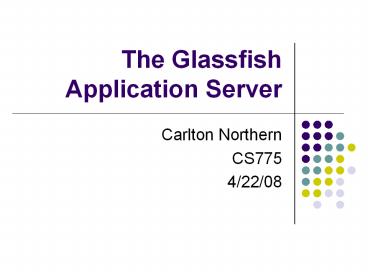The Glassfish Application Server PowerPoint PPT Presentation
1 / 20
Title: The Glassfish Application Server
1
The Glassfish Application Server
- Carlton Northern
- CS775
- 4/22/08
2
Overview
- Introduction
- Application Servers 101
- Web Application Demo
- Glassfish Features
- Netbeans and Glassfish Integration Demo
- Glassfish Web GUI Administration Demo
- Questions
- References
3
Introduction
- Glassfish is an open-source, Java Enterprise
Edition (EE) compliant application server. - The Sun Java System Application Server is Suns
commercial offering of Glassfish. - Glassfish V1 is the reference implementation of
J2EE 1.4. - Glassfish V2 is the reference implementation of
Java EE 5 (in other words J2EE 1.5). - But what is an application server?
4
Application Servers 101
- Application servers deliver applications to
client-computers through HTTP. - They differ from web servers in their extensive
use of server-side dynamic content and
integration with databases. - Typically, application servers perform the
business logic and data access for web
applications. - Example Apache Tomcat, JBOSS
5
Three-Tier Architecture
- http//en.wikipedia.org/wiki/ImageOverview_of_a_t
hree-tier_application.png
6
Why Use an Application Server?
- Question Web servers can perform all the
functionality of a an application server through
extensions like Apache Axis, so why are
application servers necessary? - Answer Application servers provide the necessary
abstraction and decoupling from web servers to
allow for greater interoperability and
portability. - App servers have standard ways to communicate to
web servers, called servlets. - App servers use containers to deploy applications.
7
Web App Deployment Demo
- http//localhost8080/LastFlickrGWT/
8
Glassfish Features
- Support for
- Java EE
- Ruby on Rails
- PHP
- AJAX
- Metro (a web services stack)
- CORBA
- Many many different frameworks
- Multiple levels of use.
- Clustering
- Grouping
- Load-Balancing
- Data Replication
- Complete Web GUI Administration
- Integration with NetBeans and Eclipse
9
Metro Web Services Stack
10
Web Services Interoperability Technologies (WSIT)
11
Multiple Level Use
- Glassfish separates functionality so that the
user only uses what is needed. - Each profile builds upon the functionality of the
previous. - Developer profile used for development of
applications. - Enterprise profile used for deployment and high
availability of applications without cluster
support. - Cluster profile used for clustering support.
12
Clustering
- Glassfish allows for the clustering of
application server instances. - Instances can be on the same or different
machines. - A cluster provides a runtime environment in which
one or more Java EE applications can be run. - Clusters provide high availability by using
failover and load-balancing. - Server instances can be added to a cluster, even
while the application is running making
clustering extremely scalable.
13
High Availability
- The High Availability feature in Glassfish
provides 99.999 availability for applications. - High Availability is offered through
- High Availability Session Persistence
- High Availability Message Service
- RMI-IIOP Load-Balancing and Failover
14
High Availability Session Persistence
- Provides high availability of HTTP requests and
session data. - Useful for mission critical web applications like
shopping carts. - Provides this through
- In-memory replication of state data on other
servers in the cluster - Using High Availability Database (HADB) (outside
of scope of this presentation)
15
In-memory Replication of Session Data
- Replicates HTTP session data and stateful session
beans (SFSBs) in the memory of server instances
on other machines. - Allows for preserving the state of an application
over server failures. - This requires the Group Management Service (GMS)
- GMS allows for notification of failures in a
group and can take action.
16
High Availability Java Message Service (JMS)
- JMS is an API that allow Java EE applications to
create, send, receive and read messages. - JMS allows message delivery semantics like once
and only once delivery and also message ordering. - JMS is made highly available through connection
pooling, failover and clustering. - Connection pooling is the act of caching
frequently used connections to a service rather
than discarding them after each use. - JMS instances are clustered in a peer-to-peer
relationship utilizing a common data store
(HADB). - These clusters utilize GMS and therefore can take
advantage of failover.
17
Netbeans Glassfish Integration
- Demonstration in Netbeans
18
Web GUI Administration Demo
- http//localhost4848/
19
Questions
- QA
20
References
- http//docs.sun.com/app/docs/coll/1343.5
- http//en.wikipedia.org/wiki/Three-tier_(computing
) - https//glassfish.dev.java.net/
- http//www.netbeans.org/

